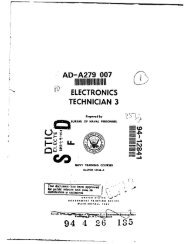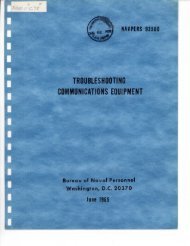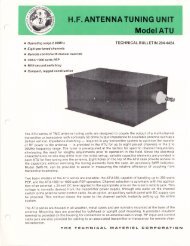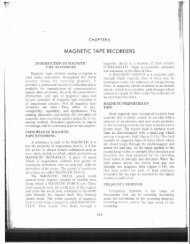L - VIR History
L - VIR History
L - VIR History
You also want an ePaper? Increase the reach of your titles
YUMPU automatically turns print PDFs into web optimized ePapers that Google loves.
ELECTRONIC CIRCUITS NAYSHIPS<br />
did not exist in the input signal. At the same time, ol!<br />
modulation components present on the original signal<br />
must be effectively transferred to the new signals. The<br />
desired output frequency is then selected by u tuned<br />
circuit and separated jroz GI! :he ather ~n!vg.qted<br />
frequencies. The manner ~n which this is accomplished<br />
is a:,;iin in :he cccompayi?: i!!nstrotinns.<br />
Flrst, ler us exottur!e the tions!er chorccteiistic<br />
of o crysta! diode and compare i! with n iineor<br />
characteristic, as shown in the accornpcnyicg illusrrotions.<br />
CRYSTAL DIODE<br />
LINEAR<br />
CHARAC FERlCTiC CHASCCTERIST~C<br />
As the input voltage to the nystol varies the current<br />
also varies, but not equally for all increments of<br />
input voltoqe. On the other hond, the ideal linear<br />
cave xi!! result ir ecu?! current increments ior eqtioi<br />
voltage increments. If the diode voltagecurrent chorocteiistic<br />
were linear, :he in?ut :1vs!!3qe would prduce a current<br />
which, when passed throuqh a resistor or lad impedoncn.<br />
would produce on output voltage identical to the input<br />
voltage. Therefore, if two different voltages were<br />
;ppi:ed os inputs, emct!y :he s;ze ?~c!to:es wnuid be<br />
obtained in the output (except for a siigklt io~s ke to thc<br />
resistance in the crystal). Thus, frequenq conversic.<br />
could not occur if the diode transfer characteristic<br />
were lineor. On the other hond, when on input voltase is<br />
applied to the nonlinwr diode, u distorted output is 05.<br />
toined. The distortion consists of signals which differ<br />
in frequency from the original signal. Ii two oliierenr<br />
signals are applied to the nonlinear diode, the output<br />
cirwi: contains distnr!inn products for both signois.<br />
These ex:::reous siqnais ore rhe sum uln: ;iiieii:;c I:-qiier.cies<br />
of !he ciqinai siqnais, $us i~is k:&:zn !.$<br />
.<br />
origind siqnois rne 51s[orLic?~ fixd~;s :..!.::!, :.:<br />
hmt signals themselves), as iilustrated below.<br />
To produce the desire0 ccnvrrsiuu w;:F. :i:;l::'j,<br />
one input (usually the input supplied by the loco;<br />
osiipiot-. ,: ...",. -,,- t 2e !arjerrl>zr~ !la othei. ?,;s is e7511.;<br />
occonollshed by using tile we24 hi$-ireqienc,; i?;~!<br />
siqnol as the small signal, and the stronq iocoi-osc11;u~ut<br />
ciqnnl as the larae signal. When the input voltage is<br />
large enough to appear at the point of greatest lniiection<br />
on the dihie characteristic curve, the hest efficiency is<br />
obtoind. The !o!!owinq !!gure iliilstmles the io-;i-iii-r.<br />
tmn4ier ~,,,~i>i~"ii". in ;fi?-, :he s::1.111 2p.i: iij?,7l 11<br />
8-8 A,."<br />
5 ,,L<br />
,,..,. '!! ,:,~,7






